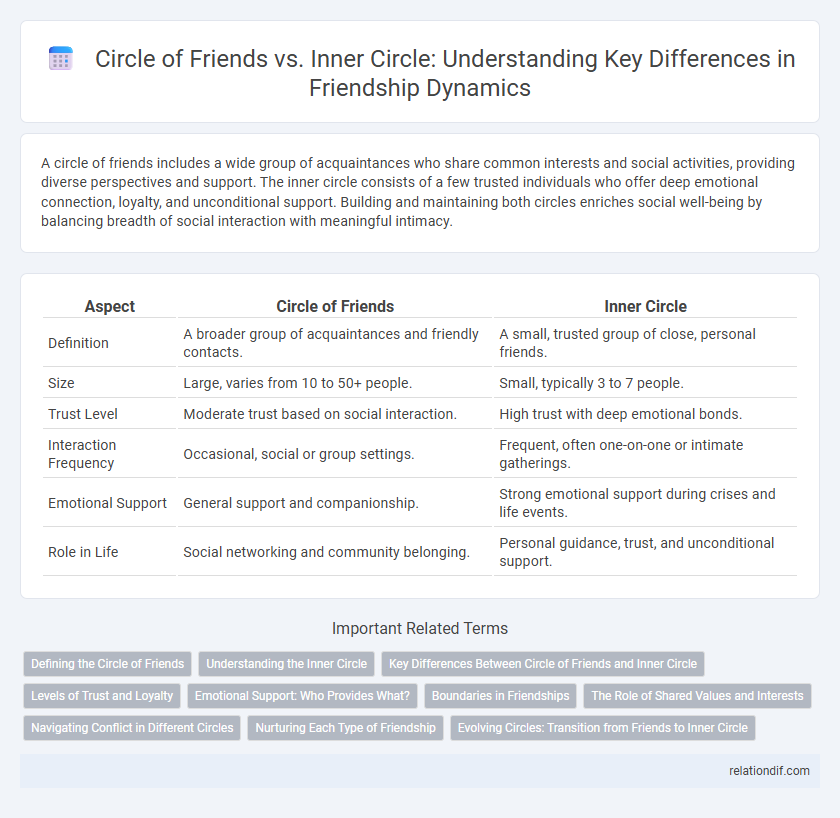A circle of friends includes a wide group of acquaintances who share common interests and social activities, providing diverse perspectives and support. The inner circle consists of a few trusted individuals who offer deep emotional connection, loyalty, and unconditional support. Building and maintaining both circles enriches social well-being by balancing breadth of social interaction with meaningful intimacy.
Table of Comparison
| Aspect | Circle of Friends | Inner Circle |
|---|---|---|
| Definition | A broader group of acquaintances and friendly contacts. | A small, trusted group of close, personal friends. |
| Size | Large, varies from 10 to 50+ people. | Small, typically 3 to 7 people. |
| Trust Level | Moderate trust based on social interaction. | High trust with deep emotional bonds. |
| Interaction Frequency | Occasional, social or group settings. | Frequent, often one-on-one or intimate gatherings. |
| Emotional Support | General support and companionship. | Strong emotional support during crises and life events. |
| Role in Life | Social networking and community belonging. | Personal guidance, trust, and unconditional support. |
Defining the Circle of Friends
The Circle of Friends consists of a broad network of acquaintances who provide social interaction and casual support, often including coworkers, classmates, and community members. Unlike the Inner Circle, which is composed of trusted individuals with deep emotional bonds and consistent, reliable support, the Circle of Friends offers a wider range of perspectives and social opportunities without the same level of intimacy. Understanding this distinction helps clarify the varying degrees of connection and support within personal relationships.
Understanding the Inner Circle
The inner circle represents a select group of trusted individuals who provide deep emotional support and share core values, distinguishing them from the broader circle of friends. Understanding the inner circle involves recognizing the quality of intimacy, loyalty, and reliability that defines these relationships. Prioritizing this close-knit group fosters stronger bonds and enhances personal well-being through consistent and meaningful connection.
Key Differences Between Circle of Friends and Inner Circle
The circle of friends encompasses a diverse group of acquaintances with varying degrees of closeness, while the inner circle consists of a small, trusted group of individuals who provide emotional support and confidentiality. Key differences include the level of intimacy, frequency of interaction, and depth of trust, with the inner circle often playing a pivotal role in major life decisions and personal growth. Understanding these distinctions helps clarify social dynamics and prioritize meaningful relationships effectively.
Levels of Trust and Loyalty
The circle of friends encompasses a broader group where trust is moderate and loyalty varies based on shared experiences and social interactions. In contrast, the inner circle is characterized by deep levels of trust and unwavering loyalty, often reserved for those who provide emotional support and confidentiality. This distinction highlights the varying degrees of intimacy and reliability within personal relationships.
Emotional Support: Who Provides What?
The inner circle provides deep emotional support characterized by unwavering trust, empathy, and vulnerability, often acting as a primary source of comfort in times of crisis. The broader circle of friends offers diverse perspectives and social engagement, helping to alleviate loneliness and provide encouragement through shared experiences. While the inner circle meets core emotional needs, the outer circle contributes to overall well-being by expanding social interactions and reducing isolation.
Boundaries in Friendships
Establishing clear boundaries differentiates a circle of friends from an inner circle by defining levels of trust, intimacy, and emotional support. While the circle of friends includes casual acquaintances with flexible interactions, the inner circle demands deeper respect for personal limits and consistent mutual understanding. Respecting these boundaries ensures emotional safety and strengthens the quality of friendships within the inner circle.
The Role of Shared Values and Interests
Shared values and interests are fundamental in shaping both the circle of friends and the inner circle, as they create a strong foundation for trust and mutual understanding. While the broader circle of friends often consists of acquaintances with overlapping hobbies or social activities, the inner circle deepens these connections through aligned core beliefs and long-term goals. This alignment ensures emotional support and loyalty during challenges, distinguishing close friendships from more casual social interactions.
Navigating Conflict in Different Circles
Navigating conflict in a circle of friends requires balancing group dynamics and individual perspectives, often emphasizing diplomacy to maintain harmony. In contrast, resolving disputes within an inner circle allows for deeper, more candid conversations rooted in trust and emotional investment. Understanding these distinctions helps in applying appropriate conflict resolution strategies tailored to the nature of each social circle.
Nurturing Each Type of Friendship
Nurturing a circle of friends involves maintaining diverse social connections that offer broad support and varied perspectives, while cultivating an inner circle requires deeper emotional investment and trust with a select few who provide consistent loyalty and understanding. Prioritize regular communication, shared experiences, and vulnerability to strengthen these bonds, recognizing that the quality of interactions within the inner circle often leads to greater emotional resilience. Balancing time and energy between these two types of friendships enhances social well-being and personal growth.
Evolving Circles: Transition from Friends to Inner Circle
Evolving circles in friendship highlight the transition from a broad circle of friends to a trusted inner circle, where emotional intimacy deepens and loyalty solidifies. The inner circle typically consists of individuals who provide unwavering support, shared values, and long-term commitment, distinguishing them from the wider network of acquaintances. This progression reflects the natural filtering of relationships based on trust, reliability, and meaningful connection over time.
Circle of Friends vs Inner Circle Infographic

 relationdif.com
relationdif.com